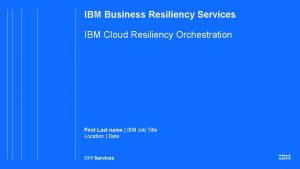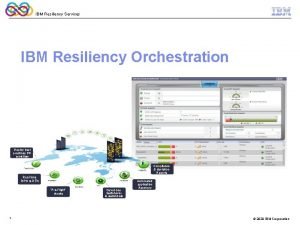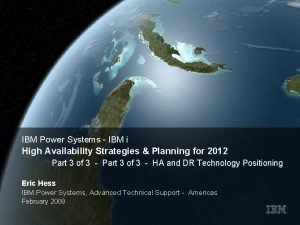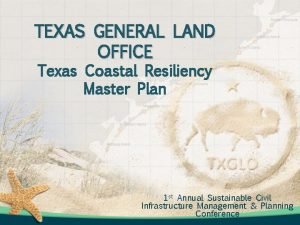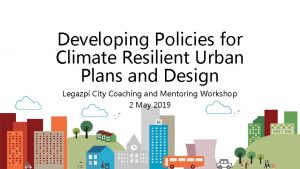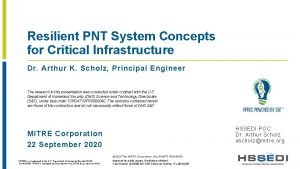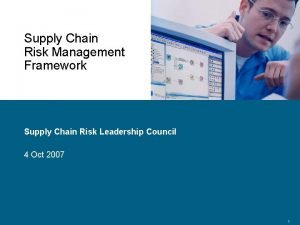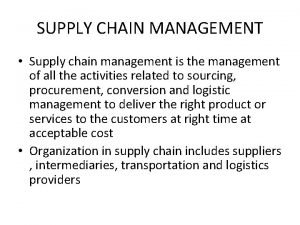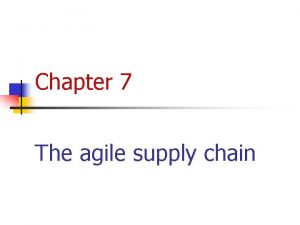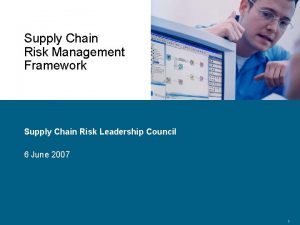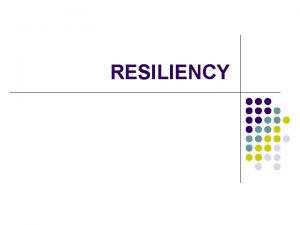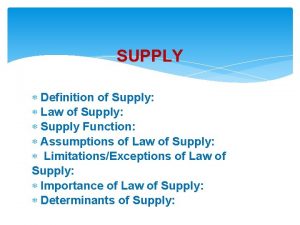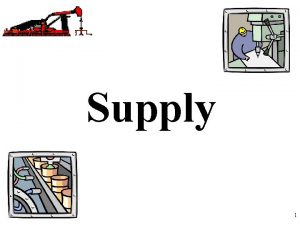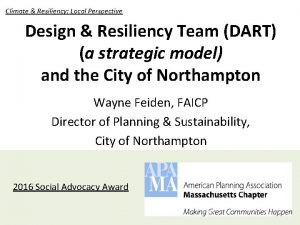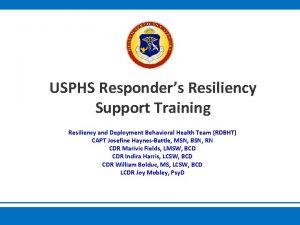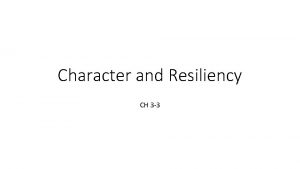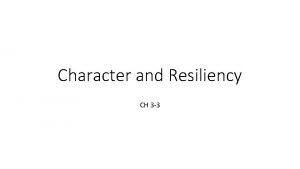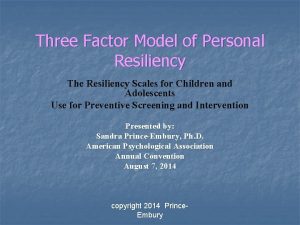A Supply Network Resiliency Assessment Framework Authors Jaspar





















- Slides: 21

A Supply Network Resiliency Assessment Framework Authors: Jaspar Siu, Santosh Stephen Advisor: James B. Rice, Jr. MIT SCM Research FEST May 21, 2015

Supply Chain Resiliency - the ability of a supply chain network to bounce back from a disruption. 1

Why is Supply Chain Resiliency Important? Albuquerque, NM Impact: Sole Sourced Supplier Production down for weeks $M’s of chips destroyed Phone Manufacturer 2 Response Fast, Proactive Slow, Reactive Business Impact $ Market share rose from 27% to 30% Market share fell from 12% to 9%, lost $2. 34 Billion Source: Yossi Sheffi, “The Resilient Enterprise”, MIT Press, 2005

Agenda • Problem • Approach • Visualization • Results & Insights 3

Problem with Resiliency today Based on gut-feel and intuition Lack formal process to evaluate and visualize supply chain risk resiliency Unclear where to spend mitigation dollars and how much 4 Problem Approach Visualize Results

3 Key Takeaways 5 1 Quantify resilience in supply chain 2 Visualize supply chain risk 3 Quantify the value of mitigation options Problem Approach Visualize Results

Agenda • Problem • Approach • Visualization • Results & Insights 6

Definitions: Timeline of a Disruptive Event TTR: Time to Recover 30 days TTB: Time to Backup 20 days Steady State Timeline Disruptive Event 7 days Downstream Inventory Impact Baseline Supply Backup Supplier Disruption 13 days Black out period 10 days Back up period Business Impact = Lost Sales Contribution + Increased Cost Problem Approach Visualize Results

Explanation: Computing Expected Business Impact Total Business Impact Expected Business Impact Probability Geo-political risk Lost Contribution Blackout Period X Part Volume Rate Problem Contribution / Unit Approach Cost Increase Backup Period X WIP Volume Rate Visualize Natural Disaster risk Supplier risk Cost Increase / Unit Results Process risk

Example: Expected Business Impact at a Node 9 Problem Approach Results Insights

Example: Expected Business Impact at a Node Example Description Minor • Process failures • Minor quality issues • Relatively low impact • Medium or high probability events Major • Earthquakes • Vendor bankruptcy • High impact • Low probability events Problem Approach Visualize Results

Agenda • Problem • Approach • Visualization • Results & Insights 11

ABC Company’s Supply Chain – One Raw Material Commodity Facts: 12 • Used in 134 parts • 3 suppliers • 6 locations • 3 stages of processing then ODM Problem Approach Visualize Results

Map view: Expected Business Impact Risk • Sourcemap enables supply chain visualization for: • Node locations • Directional flow of material • Business impact metric • Color-coded Problem Approach Visualize Results

SC network view: Expected Business Impact Risk • SC Network Visualization allows us to see: • ODM ~ 1. 73 M exp. BI • Supplier 1 highest exp. BI • Assembly process highest exp. BI 14 Problem Approach Visualize Results

Agenda • Problem • Approach • Visualization • Results & Insights 15

Results: Identify and Prioritize Risky Locations and Suppliers E 1 730 Risk by facility ($K) C 290 238 188 A B 153 D ODM 1 A 1 B 2–R 2 2 -R 1 3 -R 1 F 1 964 Risk by location ($K) A • Identifying Critical Entities: • Supplier 1 • Location A 290 188 153 75 B C D E F • Location A: ~ $2 M due to concentration of suppliers Risk by supplier ($K) ODM 16 • Supplier 1: ~ $600 k due to 2 facilities 1 Problem 2 3 Approach Visualize Results

Results: Quantifying Value of Mitigation Options Expected Business Impact vs. ODM Inventory 3000 2500 $200 K decrease per day TOTAL Exp. BI ($K) Dollars ($K) 2000 1500 $10 K decrease per day 1000 500 0 0 1 2 3 4 5 6 7 8 9 10 11 ODM Inventory (Days) 17 Problem Approach Visualize Results 12 13 14

Results: Quantifying Value of Mitigation Options Expected Business Impact vs. Time to Recover (TTR) 3050 2950 $1 K decrease per day Dollars ($K) 2850 2750 $12 K decrease per day 2650 TOTAL Exp. BI ($K) 2550 2450 2350 0 1 2 3 4 5 6 7 8 9 10111213141516171819202122232425262728293031323334353637383940414243444546474849 Time to Recover (Days) 18 Problem Approach Visualize Results

Insights 1. Tension is present between efficiency and risk. 2. Visualizing supply chain risk helps managers understand geographic location risk. Risk aggregates when same suppliers or locations occur multiple times. 3. Risk depends on Time-To-Recovery (TTR), Time-To-Backup (TTB), downstream inventory, supply chain structure, and volume of flow. 4. Choice of mitigation option, and extent of investment depends on marginal benefit of option vs. additional cost (illustrated from response curves). 19 Problem Approach Visualize Results

3 Key Takeaways 20 1 Quantify resilience in supply chain 2 Visualize supply chain risk 3 Quantify the value of mitigation options
 Ibm resilient map customer journey
Ibm resilient map customer journey Business continuity and resiliency services
Business continuity and resiliency services Resiliency orchestration
Resiliency orchestration Ibm geographically dispersed resiliency for power systems
Ibm geographically dispersed resiliency for power systems Ibm geographically dispersed resiliency for power systems
Ibm geographically dispersed resiliency for power systems Sgip equity resiliency program
Sgip equity resiliency program Texas coastal resiliency master plan
Texas coastal resiliency master plan Protective factors definition
Protective factors definition Calactite
Calactite Resilient pnt
Resilient pnt Chapter 5 section 1 supply
Chapter 5 section 1 supply Ano ang ratio ng elastisidad
Ano ang ratio ng elastisidad Matching supply with demand
Matching supply with demand Supply chain risk management framework
Supply chain risk management framework Supply chain risk management framework
Supply chain risk management framework Supply chain it framework
Supply chain it framework Agile supply chain framework
Agile supply chain framework Supply chain risk management
Supply chain risk management Operational research
Operational research Dispositional framework vs regulatory framework
Dispositional framework vs regulatory framework Conceptual and theoretical framework example
Conceptual and theoretical framework example Theoretical framework example
Theoretical framework example
